Drilling
A field test study examines micro turbine drilling in a clay formation that allows steel casing and formation to be drilled in a single operation.
The discovery in the Kutei Basin offshore Indonesia is being considered for fast-track development.
The Gorgon Phase 3 project aims to counter declining reservoir pressure to sustain gas supplies to Western Australia’s domestic market and support LNG exports to Asia.
-
When humankind returns to the Moon to establish colonies it will be bringing with it technologies born in the oil and mining industries. The European Space Agency and Russia’s Roscosmos will be central to that effort as they prepare to land a robotic drilling system to extract oxygen and water from frozen lunar soil.
-
The authors describe challenges that must be overcome to reach the goal of drilling systems automation.
-
This paper details the introduction of a drilling automation system to deliver superior well-construction performance in a major gas field.
-
MPD was used to successfully drill through a pore pressure ramp and address a well-control event in conjunction with conventional methods.
-
Drilling automation and innovation continue as dominant trends despite market downturns and unprecedented challenges in the past year. In many ways, the drive toward new efficiencies and step changes in well-construction performance has taken on an even greater sense of urgency.
-
The cutting-edge technological developments in geothermal are devoted to drilling into deeper, hotter, and harder rock. Oil and gas expertise and know-how holds the key to cost reduction.
-
The complete paper discusses a geophone array, including four, three-component geophones deployed by wireline, that provides a solution for this problem by creating a 3D map of the acoustic environment.
-
The complete paper presents a solution that integrates a physics-based torque-and-drag (T&D) stiff/soft string model with a real-time drilling analytics system using a custom-built extract, transform, and load translator and digital-transformation applications to automate the T&D modeling work flow.
-
The complete paper discusses a new performance-evaluation methodology that combines bottomhole assembly (BHA) modeling with field data.
-
The complete paper presents a methodology designed for optimally matching drill bits, mud motors, and bottomhole-assembly components for reduced failure risks and improved drilling performance.













